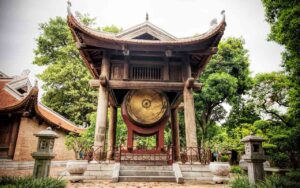The stele of the doctoral examinations of the Later Le and Mac dynasties at the Temple of Literature – Hanoi is a world documentary heritage under UNesco’s memory of the world program, established in 2010.

Doctoral steles at the Temple of Literature have a total of 82 stone steles, engraved with epitaphs naming doctors of Vietnamese Confucianism from the Imperial examinations of the late Le and Mac dynasties (1442 – 1779) at the Temple of Literature – Quoc Tu Giam, Hanoi. The stele is placed on the back of a stone turtle to represent the longevity of the national essence, reflecting the cultural and historical values of the country for 300 years.
All 82 doctoral stele are crafted in the same style: Flat stele, curved forehead, domed shape. The stone steles are all placed on the backs of turtles, the turtles are carved in one style: big, bold, and strong. The way to use the stele is also very unique: The stone for the stele is carefully selected, then designed, decorated, carved with patterns and inscriptions. Because it is done entirely by hand, this work requires patience and dexterity from the craftsman.

The 82 stone steles at Hanoi’s Temple of Literature are the only doctoral steles in the world with inscriptions (Steleta) that not only record the names of doctors who passed exams spanning nearly 300 years ( from 1442 to 1779) but also records the history of examinations and the dynasty’s philosophy on education, training, and use of talents. The epitaphs also clearly state the date the stele was erected, the name of the person who composed the stele, and the person who erected the stele. This confirms the authenticity, originality and uniqueness of the document. The epitaphs were all compiled by the country’s great cultural and intellectual figures, so they are basically priceless literary works.
Each stele is a delicate and unique piece of sculptural art with elaborate, highly stylized decorative patterns such as flowers, clouds, moon, dragon, lily, tortoise, and phoenix. The writing on the stele, the decorative patterns, and the styling style of the stele and turtle all bear the mark of the era that produced them. Many art researchers have considered this an important document in the process of researching the history of Vietnamese art and sculpture from the 15th to the 18th century.
